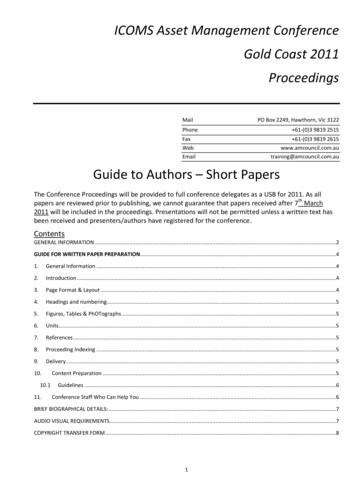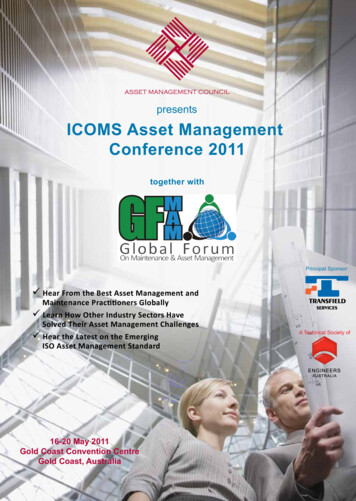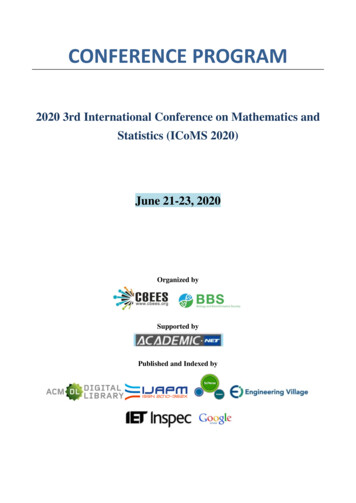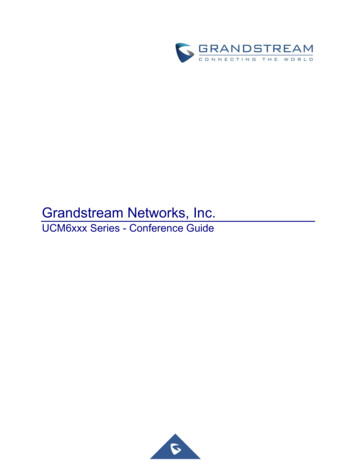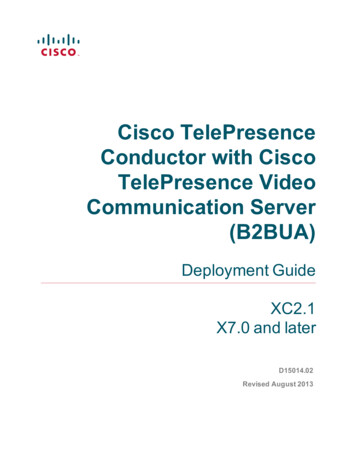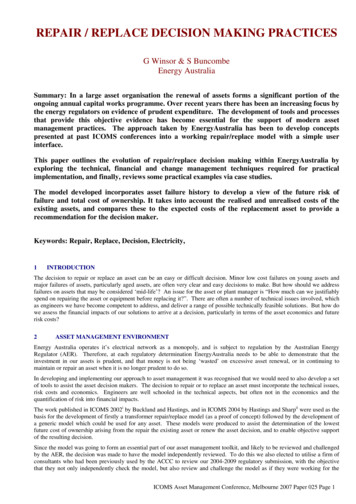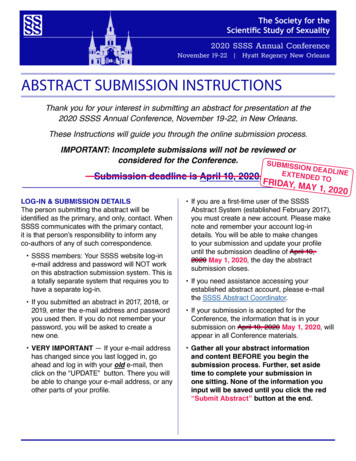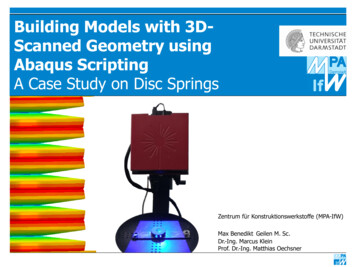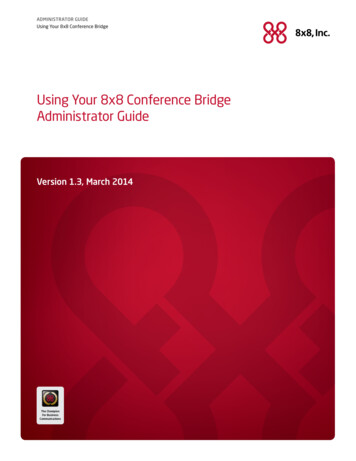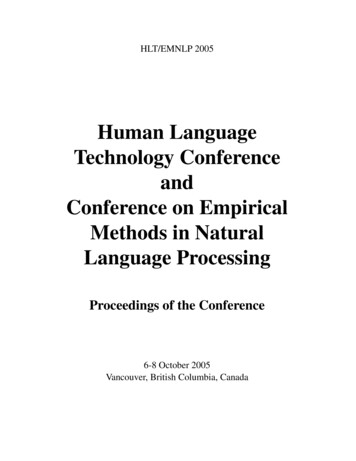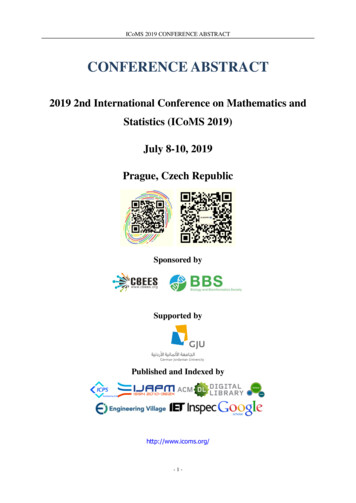
Transcription
ICoMS 2019 CONFERENCE ABSTRACTCONFERENCE ABSTRACT2019 2nd International Conference on Mathematics andStatistics (ICoMS 2019)July 8-10, 2019Prague, Czech RepublicSponsored bySupported byPublished and Indexed byhttp://www.icoms.org/-1-
ICoMS 2019 CONFERENCE ABSTRACTTable of ContentsICoMS 2019 Conference Introduction4Presentation Instruction5Honored Speaker Introduction6Detailed Schedule of Conference13Session 1: Computational Mathematics and Applied MathematicsP0007: Robust G-Optimal Designs Against Model Misspecification in the Presence of 15Block EffectsPeang-or Yeesa, Patchanok Srisuradetchai and John J. BorkowskiP1001: Multidimensional Catalytic Branching Random Walk with Regularly Varying 16TailsEkaterina Vl. BulinskayaP0022: Mathematical Modeling and Simulation of 3-Qubits Quantum Annealing 16ProcessorSaud Owyed, A. Abdel-Aty, Mohamed Mabrok and Nordin ZakariaP0026: Using Fuzzy Bits and Neural Nets to Partially Invert Few Rounds of Some 16Cryptographic Hash FunctionsSergij V. GoncharovP2003: ESProNet: A Model Library for the Dynamic Simulation of Industrial Symbiosis 17Martin Maiwald, Linda Kosmol, Christoph Pieper and Thorsten SchmidtP2004: Phase Field Modelling of the Chemo-Mechanical Responses of Solid Solutions 18Far from EquilibriumSantiago Peña Clavijo, Luis FR Espath and Victor M. CaloP2006: Numerical Effects in Computer Simulation of Simplified Hodgkin-Huxley 18ModelValerii Y. Ostrovskii, Timur I. Karimov, Ekaterina P. Solomevich, Georgii Y. Kolevand Denis N. ButusovP2013: Packing of R3 by CrossesCatarina M. N. Cruz and Ana M. D’Azevedo Breda18Session 2: Statistical ScienceP0003: Comparing the First and the Second Orders of Random Coefficient 20Autoregressive Model on Time Series DataAutcha Araveeporn and Somsri BanditvilaiP0018: Adaptive Estimation of Autoregressive Models Under Long-Tailed Symmetric 20DistributionBegüm Yentür, Özlem Türker Bayrak and Ayşen Dener AkkayaP0009: Factors Affecting Efficiency of Police Stations in Metropolitan Police Division 3 21Pornpimol Chaiwuttisak-2-
ICoMS 2019 CONFERENCE ABSTRACTP0019: Generalized Linear Model Approach for Medical DataNeriman Akdam and Neslihan Iyit22P0023: Forecasting Models of Chinese, Malaysian and South Korean Tourists Visiting 22ThailandSomsri Banditvilai and Siriluck AnansatitzinP0015: Estimation and Use of Correlation in Multiple Hypothesis Testing with High 23Dimensional DataPianpool KirdwichaiP0020: Exponential Power-Chen Distribution and Its Some PropertiesNoorsl Ahmed Zeenalabiden and Buğra Saraçoğlu23P0004: Comparing Penalized Regression Analysis of Logistic Regression Model with 24MulticollinearityAutcha Araveeporn and Choojai KuharatanachaiPoster SessionP1004: Fatality Involving Road Accidents in Malaysia: A Comparison between Three 25Statistical ModelsAlvin Ho Chun Wai, Sam Yi Seng and Jeff Lai Wan FeiP2007: Development of University Scientific Knowledge Ontological Model25Gulnaz Zhomartkyzy, Saule Kumargazhanova, Galina Popova and LauraSuleimenovaP1005: Valuation of Real Estate: A Multiple Regression ApproachWong Mei Chin, Nicholas Lee Wen Kit and Jeff Lai Wan Fei26P2008: Bayes Reliability Analysis of Parameters of Generalized Pareto Distribution 26Under Different Loss FunctionsSong Ying and Cao YuanpingP1006: Behaviour of Malaysia and Vietnam Exchange Rate in Response to Changes in 26Inflation RateKhoo Jie Yuin, Yong Poh Yee and Ganeshsree SelvachandranP2014: Developing a Model for Managing the Curriculum Model Competency FormIndira Uvaliyeva, Saule Kumargazhanova and Gulnaz Zhomartkyzy27P1009: Behaviour of Malaysia and Australia Exchange Rate in Response to the Prices 27of CommoditiesWearn Qian Soon, Leng Poh Hong and Ganeshsree SelvachandranP1010: Effects of High Frequency Trading on the Malaysian Stock MarketFaith Kabanda, Ali Alaali and Yap Hong Keat28Conference Venue29Academic Visit & Tour30Note32Feedback Information35-3-
ICoMS 2019 CONFERENCE ABSTRACTIntroductionWelcome to 2019 2nd International Conference on Mathematics and Statistics (ICoMS 2019),which is organized by Hong Kong Chemical, Biological & Environmental Engineering Society(CBEES) and Biology and Bioinformatics (BBS), and is supported by German JordanianUniversity, Jordan. The objective of 2019 2nd International Conference on Mathematics andStatistics (ICoMS 2019) is to provide a platform for researchers, engineers, academicians aswell as industrial professionals from all over the world to present their research results anddevelopment activities in Mathematics and Statistics.Papers will be published in the following proceeding or journal:ACM Conference Proceedings (ISBN: 978-1-4503-7168-1): archived inACM Digital Library, indexed by EI Compendex and SCOPUS, and submittedto be reviewed by Thomson Reuters Conference Proceedings Citation Index(ISI Web of Science).International Journal of Applied Physics and Mathematics (IJAPM) (ISSN:2010-362X), which will be indexed by EI (INSPEC, IET), Index Copernicus,CAS ect.Conference website and email: http://www.icoms.org/; icoms@cbees.net-4-
ICoMS 2019 CONFERENCE ABSTRACTPresentation InstructionInstruction for Oral PresentationDevices Provided by the Conference Organizer:Laptop Computer (MS Windows Operating System with MS PowerPoint and Adobe AcrobatReader)Digital Projectors and ScreenLaser StickMaterials Provided by the Presenters:PowerPoint or PDF Files (Files should be copied to the Conference laptop at the beginning ofeach Session.)Duration of each Presentation (Tentatively):Keynote Speech: about 45 Minutes of Presentation and 5 Minutes of Question and AnswerInvited Speech: about 15 Minutes of Presentation and 5 Minutes of Question and AnswerOral Presentation: about 12 Minutes of Presentation and 3 Minutes of Question and AnswerInstruction for Poster PresentationMaterials Provided by the Conference Organizer:The place to put posterMaterials Provided by the Presenters:Home-Made Posters: Submit the poster to the staff when signing inPoster Size: A1 (841*594mm)Load Capacity: Holds up to 0.5 kgBest Presentation AwardOne Best Oral Presentation and one Best Poster Presentation will be selected from eachsession, and the Certificate for Best Presentation will be awarded at the end of each session onJuly 9, 2019.Dress CodePlease wear formal clothes or national representative of clothing.-5-
ICoMS 2019 CONFERENCE ABSTRACTHonored Speaker IntroductionKeynote Speaker IProf. João Tiago Praça Nunes MexiaUniversidade Nova de Lisboa, PortugalProf. João Tiago Praça Nunes Mexia was born in Lisbon in June of 1939. The most part ofhis career was as Full Professor at the FCT/UNL-Faculty for Sciences and Technology of theNew University of Lisbon. At that time he supervised the teaching of Statistics at FCT/UNLand directed the Research Center in Mathematics of the University (CMA-Center forMathematics and its Applications) from 1999 to 2009. In 2009 he became Emeritus Professor.Until now he supervised 19 Ph.D. and co-supervised 12 Ph.D. His research is centered onLinear Statistical Inference, having almost 100 papers published in International Journals.Topic: "Confidence Ellipsoids for Additive Pearsonian Models"Abstract—We use a classical result on Cumulant Generation Function to obtain Least SquaresEstimators for the components, assumed to be independent and identically distributed of thevectors Z1 ,.,Z m of an additive modelmY X 0 0 X i Zi ei 1wher 0 is fixed and the Z1 ,.,Z m and e are assumed to be independent and e will benormal homoscedastic.We then obtain the cumulants of order 2, 3 and 4 of the U h T Y , h 1, ,n, with X 0 0 and the 1 ,., n constituting an orthonormal basis for IRn:Applying the Edgeworth Expansions we obtain (approximate) quantiles u p,l-6-
ICoMS 2019 CONFERENCE ABSTRACTfor the U h , h 1, ,n. We will adjust confidence ellipsoids to these quantiles reducing thequadratic form to an inner product. Thusv T Mv v 2 T s( M ),where, with v v 1 ,.,v w and M [m l,h ] we have v 2 (v 12 ,.,2v 1v w ,.,v w2 )ands( M ) (m1,1 ,., m1,w ,., m w, w ) .Using the geometrical argument, see Scheffé(1959), we will obtain joint confidence intervalsfor the T .-7-
ICoMS 2019 CONFERENCE ABSTRACTKeynote Speaker IIProf. Carlos A. BraumannUniversity of Évora, PortugalCarlos A. Braumann is Emeritus Professor and member of Departamento de Matemática,Escola de Ciências e Tecnologia, Universidade de Évora; Centeo de Investigação em Matemática e Aplicações da Universidade de Évora, Instituto de Investigação e Formaçao Avançada,Universidade de Évora where he has been Vice-Rector in 1987-94 and Rector in 2010-14. Hispublications are mostly on Stochastic Differential Equations and its applications in severalareas (population dynamics, fisheries, animal growth, demography, finance). He got his Ph.D.in 1979 at the Stony Brook University and his habilitation in Stochastic Processes at the UE in1988. He is an elected member of the International Statistical Institute since 1992, a formerPresident of the European Society for Mathematical and Theoretical Biology (2009-12) and ofthe Portuguese Statistical Society (2006-09 and 2009-12), and a former member of theEuropean Regional Committee of the Bernoulli Society (2008-12).Topic: "Individual Growth Modelling with Stochastic Differential Equations"Authors: Carlos A. Braumann, Patrícia A. Filipe and Gonçalo JacintoAbstract—Common growth curves for the weight X(t) of an animal at age t can be describedby a differential equation of the form dY(t) β(α-Y(t))dt, where Y(t) h(X(t)) and h is anappropriate strictly increasing continuously differentiable function, α h(A) (A maturityweight of the animal), and β 0 is a rate of approach to maturity. Adjustment to data wasusually done through non-linear regression inappropriate methodology that ignores the growthdynamics and the influence of environmental fluctuations on it. Instead, we use insteadstochastic differential equations (SDEs) models dY(t) β(α-Y(t))dt σdW(t), where W(t) is astandard Wiener process and σ is an intensity parameter of the fluctuations. We havepreviously studied estimation, prediction and optimization issues using cattle weight datafrom females of Mertolengo cattle breed. In the present work, we have adjusted and appliedthe methodologies to the weight data of males of Mertolengo cattle breed and Alentejanacattle breed. Since model parameters may vary from animal to animal and that variability canbe partially explained by their genetic differences, we introduce the extension of the study toSDE mixed models. These mixed models incorporate the individual genetic values that areavailable at the databases of the producer associations.-8-
ICoMS 2019 CONFERENCE ABSTRACTAcknowledgements: The authors belong to the research centre Centro de Investigação emMatemática e Aplicações (CIMA), Universidade de Évora, supported by FCT (Fundação paraa Ciência e a Tecnologia, Portugal, project UID/MAT/04674/2019).-9-
ICoMS 2019 CONFERENCE ABSTRACTInvited Speaker IProf. Alexander BulinskiMoscow State University, RussiaAlexander Bulinski, Professor of the Moscow State University, Dr. Sc. Phys. Math.(Habilitation) is a Member of the Board of the Moscow Mathematical Society since 2000,was a Member of the European Committee of the Bernoulli Society (2002-2006). He is anauthor of 5 books and numerous research papers. His main results pertain to the theory ofstochastic processes and random fields. Various statistical applications of limit theorems arealso in the scope of his activity. A.Bulinski belongs to the scientific school of ProfessorA.N.Kolmogorov being his former PhD student. He was awarded the State Scholarship forprominent scientists and International Science Foundation Diploma for outstandingcontribution to world science and education''. He is a winner of the Lomonosov prize inScience. A.Bulinski is a Member of the Editorial Boards of 6 journals. He was InvitedProfessor in France, Germany, Sweden, Netherlands, UK etc. Under his scientific direction 15PhD-theses were written and 4 are in preparation. He was Keynote Speaker and InvitedSpeaker, as well as a member of Program Committees, at various International conferences.A.Bulinski is a Member of the Expert Council for Higher Qualification Committee of Russia,Head of the Federal Teaching Union on Mathematics and Mechanics in the Higher EducationSystem of Russia.Topic: "Statistical Estimation of Mutual Information and Applications"Abstract—Statistical estimation of mutual information is important for various applications.Such estimates are employed, for instance, in machine learning, feature selection andidentification of textures inhomogeneities. In this regard one can refer, e.g., to the book byV.Bolon-Canedo and A.Alonso-Betanzos (2018), see also a review by J.R.Vergara andP.A.Estevez (2014). We develop the quite recent papers by A.Bulinski, A.Dimitrov (2018)and A.Bulinski, A.Kozhevin (2018), concerning the Shannon entropy, to study statisticalestimation of mutual information and the Kullback-Leibler divergence. We investigate theasymptotic properties of proposed estimates constructed by means of i.i.d. (vector-valued)observations. For this purpose we apply the techniques involving the nearest neighborstatistics. Special attention is payed to results of computer simulations in the framework ofmixed models (see, e.g. F.Coelho, A.P.Braga, M.Verleysen (2016), W.Gao, S.Kannan,P.Viswanath (2018)) comprising the widely used logistic regression. In contrast to previous- 10 -
ICoMS 2019 CONFERENCE ABSTRACTworks we do not suppose that the set of a response variable values is endowed with nontrivialmetric. This is essential in many cases for analysis of medical and biological data.- 11 -
ICoMS 2019 CONFERENCE ABSTRACTInvited Speaker IIProf. Xingbo WangFoshan University, ChinaDr. & Prof. Xingbo Wang got his Master and Doctor’s degrees at National University ofDefense Technology (NUDT) of China. Since 1994, he had worked at NUDT onCAD/CAM/CNC technologies till 2010. Since 2010, he has been a professor in FoshanUniversity with research interests in intelligent manufacturing system and computerapplications. Prof. Wang is now in charge of Guangdong Engineering Center of InformationSecurity for Intelligent Manufacturing System, where a lot of cryptography problems have tobe dealt with the elementary number theory. He then set up a new method to study oddintegers by means of perfect full binary tree and derived out many new properties of the oddintegers, including genetic property that makes it easier to factorize an odd integer. Now Prof.Wang is devoting himself to developing a fast algorithm to integer factorization and intendingto solve the hard problem of integer factorization.Topic: "Deterministic-embedded Monte Carlo Approach to Find out an Objective Item in aLarge Number of Data Sets"Abstract—The paper investigates an approach to find out an objective integer in a largeinteger interval. It first puts forward an approach to subdivide a large integer interval intosmall ones that are available for the Monte Carlo randomized search algorithm, then selects asmall interval by the Monte Carlo algorithm and applies a deterministic search algorithm onthe selected one. In order to make the search in an expected computing time, the paperproposes certain regulations to set an initial length for the small interval and to update it inaccordance with the expectation of the time complexity. Mathematical foundations forsetting-up the initial value and updating it to an acceptable value are presented and proved indetail and a parallel computing strategy is introduced to realized it. Except for the availabilityin integer factorization, the approach is also applicable in big data searches.- 12 -
ICoMS 2019 CONFERENCE ABSTRACTDetailed Schedule of ConferenceDay 1July 8, 2019 (Monday)Venue: Entrance Hall of Masaryk DormitoryArrival Registration10:00-16:00July 9, 2019 (Tuesday)Morning ConferenceVenue: Conference Room “Gallery”Opening RemarksProf. Carlos A. BraumannUniversity of Évora, Portugal09:30-09:40&Prof. João Tiago Praça Nunes MexiaNew University of Lisbon, PortugalKeynote Speech IProf. João Tiago Praça Nunes Mexia09:40-10:30New University of Lisbon, PortugalTopic: "Confidence Ellipsoids for AdditivePearsonian Models"10:30-11:00Day 2Coffee Break & Group PhotoKeynote Speech IIProf. Carlos A. BraumannUniversity of Évora, Portugal11:00-11:50Topic: "Individual Growth Modelling withStochastic Differential Equations"Invited Speech IProf. Alexander Bulinski11:50-12:10Moscow State University, RussiaTopic: "Statistical Estimation of MutualInformation and Applications"Invited Speech IIProf. Xingbo WangFoshan University, China12:10-12:30Topic: "Deterministic-embedded Monte CarloApproach to Find out an Objective Item in aLarge Number of Data Sets"12:30-14:00 Lunch (Atrium)Afternoon ConferenceSession 1: 14:00-16:00Venue: Conference Room “Gallery”Topic: ―Computational Mathematics and Applied Mathematics‖8 presentations- 13 -
ICoMS 2019 CONFERENCE ABSTRACT16:00-16:20 Coffee BreakSession 2: 16:20-18:20Venue: Conference Room “Gallery”Topic: ―Statistical Science‖8 presentationsPoster Session: 14:00-18:00Venue: Conference Room “Gallery”18:20-20:00 Dinner (Atrium)Day 3July 10, 2019 (Wednesday)10:00-16:00 Academic Visit & TourTips: Please arrive at the Conference Room 10 minutes before the session begins to upload PPT intothe laptop; submit the poster to the staff when signing in.- 14 -
ICoMS 2019 CONFERENCE ABSTRACTSession 1Tips: The schedule for each presentation is for reference only. In order not to miss your presentation,we strongly suggest that you attend the whole session.Afternoon, July 9, 2019 (Tuesday)Time: 14:00-16:00Venue: Conference Room “Gallery”Topic: “Computational Mathematics and Applied Mathematics”Session Chair: Prof. Xingbo WangRobust G-Optimal Designs Against Model Misspecification in thePresence of Block EffectsPeang-or Yeesa, Patchanok Srisuradetchai and John J. BorkowskiThammasat University, ThailandP0007Session 1Presentation 1(14:00-14:15)Abstract—The objective of this paper was to propose a new option forfinding robust response surface designs against model misspecification.Because of the uncertainty related to possible reduced models prior todata collection, the researcher should consider using experimental designsthat are robust across the set of potential models obtained from the weakheredity (WH) principle. Also, blocking effects were incorporated into allpossible models in this study. The geometric mean of G-optimalities wasproposed as a weighted G-optimality criterion ( G w ) to generate a robustdesign, while the genetic algorithm (GA) was employed to optimize theweighted G-optimality criterion. Robust designs in the hypercube with 8to 18 points and 2 and 3 design variables were generated with anappropriate number of blocks. The pattern for weighting the criteria inthis study was to give more weight to models with the larger number ofparameters. When a true model is the first-order or interaction model, theweighted G-optimal designs in this work have higher G-efficienciescompared to those of G-optimal designs. When a true model is asecond-order model, the G-efficiency of a weighted G-optimal design isonly slightly less than that of a G-optimal design. In this research, designpoints found using the GA would be very useful in practice forresearchers intending to run an experimental design for data collection.Multidimensional Catalytic Branching Random Walk with RegularlyVarying TailsEkaterina Vl. BulinskayaNovosibirsk State University, Russia- 15 -
ICoMS 2019 CONFERENCE ABSTRACTP1001Session 1Presentation 2(14:15-14:30)Abstract—Catalytic branching random walk (CBRW) describesreproduction of particles and their movement in space. The particles maygive offspring in the presence of catalysts. Consider CBRW model wherethe particles perform a random walk over a multidimensional lattice,without procreation outside the catalysts. The latter take a finite numberof fixed positions at the lattice. We study the particles spread in case ofnon-extinction of population initiated by a single particle. The rate ofpopulation spread depends essentially on the distribution tails of therandom walk jumps. Consider the jumps with independent (or close toindependent) components having regularly varying ―heavy’’ tails. Themain results show that, after a proper normalization of positions, in thetime limit the particles concentrate on a random set, located at thecoordinate axes. For a two-dimensional case, the limiting set forms across, and, for any higher dimension d, it is a collection of d segmentscontaining the origin. The joint distribution of such segments lengths isfound and the time-limit is understood in the sense of weak convergence.This radically differs from the known results for both the CBRW with―light‖ and semi-exponential distribution tails of the random walk jumps.Mathematical Modeling and Simulation of 3-Qubits Quantum AnnealingProcessorSaud Owyed, A. Abdel-Aty, Mohamed Mabrok and Nordin ZakariaUniversity of Bisha, Saudi ArabiaP0022Session 1Presentation 3(14:30-14:45)P0026Session 1Presentation 4(14:45-15:00)Abstract—In this paper, a new model of 3-qubits quantum annealingprocessor is designed. The spinchain model is used to simulate thequantum annealing processor. The Hamiltonian which describes thesystem is introduced and analytically solved using the unitary operatormethod taking into account, processor in, ground state. The generatedentanglement between processor parts is quantified using, concurrencemethod. The effect of quantum processor parameters on the dynamics ofentanglement is investigated. The results show that enough quantumcorrelation is generated between quantum annealing processor nodes(qubits). However, it has shown that we can control the dynamics ofentanglement over the system by controlling the system parameters.Using Fuzzy Bits and Neural Nets to Partially Invert Few Rounds ofSome Cryptographic Hash FunctionsSergij V. GoncharovOles Honchar Dnipro National University, UkraineAbstract—We consider fuzzy, or continuous, bits, which take values in[0;1] and (-1;1] instead of {0;1}, and operations on them (NOT, XORetc.) and on their sequences (ADD), to obtain the generalization ofcryptographic hash functions, CHFs, for the messages consisting of fuzzybits, so that CHFs become smooth and non-constant functions of each bitof the message. We then train neural nets, NNs, to predict the message- 16 -
ICoMS 2019 CONFERENCE ABSTRACTthat has a given hash, where the loss function for the hash of predictedmessage and given true hash is backpropagatable. We obtain and comparethe results of the trainings for standard CHFs with small number of(optionally weakened) rounds. For MD5 and SHA1, SHA2-256 NNs areable to invert 1 round with positive probability, for 2 rounds there are atleast 10 misses, then the number of misses exceeds that of matched bits.For more than 5–6 rounds, the full hash of accordingly long messages isalmost uninvertible. For SHA3/Keccak the inversion of 1 round for shortmessages can be exact; of 2 and more is very feeble. Weakened roundsmove this barrier further. Learning may delay for few initial epochs.Small group of hash bits can be matched partially.ESProNet: A Model Library for the Dynamic Simulation of IndustrialSymbiosisMartin Maiwald, Linda Kosmol, Christoph Pieper and ThorstenSchmidtTechnische Universität Dresden, GermanyP2003Session 1Presentation 5(15:00-15:15)Abstract—One approach to a more sustainable industry is the reuse ofwaste and by-products. In particular, the exchange of resources betweencompanies and the reuse of energy are considered critical, as they aretime-dependent and may require technical or organizational changes tothe production system leading to new interdependencies between thecompanies. Simulation is a suitable tool for analyzing the dynamicbehavior of production systems to identify and evaluate critical factorsand risks with regard to compatibility or feasibility, necessary changesand their effects on the system. This paper presents a modeling andsimulation approach for resource reuse and exchange in the context ofindustrial symbiosis. To distinguish the proposed method from relatedwork, an overview of existing modeling and simulation approaches ispresented. The suggested approach is based on the modeling languageModelica. A custom model library with reusable preconfigured modelelements is developed to model and simulate different production systemsand scenarios bottom-up and modularly and in order to investigateinteractions between resource providers and consumers. The conceptualand mathematical development of the model components and theirinteraction principles are presented and demonstrated. Based on this,organizational interdependencies and their economic and ecologicalimpacts can be analyzed.Phase Field Modelling of the Chemo-Mechanical Responses of SolidSolutions Far from EquilibriumSantiago Peña Clavijo, Luis FR Espath and Victor M. CaloCurtin University, AustraliaAbstract—Complex physical and chemical processes rule the evolution ofsolid solutions as the system moves towards its steady state. When- 17 -
ICoMS 2019 CONFERENCE ABSTRACTP2004Session 1Presentation 6(15:15-15:30)P2006Session 1Presentation 7(15:30-15:45)P2013considering a deformable medium, chemical reactions may affect thesolid strength and its mechanical properties. Analogously, highmechanical strength may suppress either the volumetric shrinkage orswelling associated with the local volume changes caused by thechemical processes. Moreover, the nucleation and growth of new phasesas a result of the chemical reactions may induce heterogeneous stresses.In general, the phase interfaces have a non-zero thickness where thephysical and chemical properties vary from one phase to another. Thus,the theoretical and computational modelling of solid solutions enduringchemo-mechanical processes together with interfacial interactions requireto capture the stress-assisted volume changes mechanism as the phaseinterfaces diffuse. In this effort, phase field models emerge as promisingtool to simulate interfacial phenomena. These models rely on a diffuseorder parameter to monitor the interfaces implicitly. We propose athermodynamically-consistent phase field framework to describe thedynamics of solid solutions undergoing mass transport and chemicalreactions, deformation, and interfacial interactions. Simulation resultsprovide insights into the phenomenon and verify the interleaving betweenthese chemo-mechanical processes.Numerical Effects in Computer Simulation of SimplifiedHodgkin-Huxley ModelValerii Y. Ostrovskii, Timur I. Karimov, Ekaterina P. Solomevich,Georgii Y. Kolev and Denis N. ButusovSaint Petersburg Electrotechnical University ―LETI‖, RussiaAbstract—In this paper, we consider the impact of the discretizationeffects on the dynamical behaviour of the single-compartment neuronmodel represented by simplified Hodgkin-Huxley equations. In order toimplement numerical simulation, one need to discretize the continuousmodel of the system or use the discrete operator preserving the mainproperties of the continuous prototype. However, discrete models cansuffer from negative effects caused by the applied method, discretizationstep and round-off errors. This fact is particularly important for theanalysis of nonlinear systems, e.g. the biological neuron models. Withinthis study, the impact of the application of the most common one-stepintegration methods is examined through the series of computationalexperiments, where the dynamical system is put into the resonant andchaotic oscillation modes. The results of the study are visualized astwo-parameter dynamical maps and interspike interval histograms.Packing of R3 by CrossesCatarina M. N. Cruz and Ana M. D’Azevedo BredaUniversity of Aveiro, PortugalSession 1Presentation 8Abstract—The existence of tilings of- 18 -by crosses, a cluster of unit
ICoMS 2019 CONFERENCE ABSTRACT(15:45-16:00)cubes comprising a central one andarms, has been studied by severalauthors. We have completely solved the problem forthe crosses which lattice tilecharacterizingas well as determining the maximumpacking density for the crosses which do not lattice tile the plane. In thispaper we motivate a similar approach to study lattice packings ofcrosses.16:00-16:20Coffee Break- 19 -by
ICoMS 2019 CONFERENCE ABSTRACTSession 2Tips: The schedule for each presentation is for reference only. In order not to miss your presentation,we strongly suggest that you attend the whole session.Afternoon, July 9, 2019 (Tuesday)Time: 16:20-18:20Venue: Conference Room “Gallery”Topic: “Statistical Science”Session Chair: Prof. Alexander BulinskiComparing the First and the Second Orders of Random CoefficientAutoregressive Model on Time Series DataAutcha Araveeporn and Somsri BanditvilaiKing Mongkut’s Institute of Technology Ladkrabang, ThailandP0003Session 2Presentation 1(16:20-16:35)P0018Session 2Presentation 2Abstract—The random coefficient autoregressive (RCA) modeldevelops from the autoregressive model and the hierarchical model.The RCA model has considered a constant parameter and coefficientparameter depended on past data. The least squares method is awidely used method by minimizing the sum of squared residuals anddifferential with respect to the unknown parameter. In this paper, theconcept of the least squares method is used to estimate an unknownparameter of the first and the second orders of Random CoefficientAutoregressive (RCA) model or called RCA(1) and RCA(2) models.The efficiency of the two models is to compare by considering theminimum value of mean square error. The RCA(1) and RCA(2) arethen applied to a time series data in the form of nonstationary data.The monthly averages of the Stock Exchange of Thailand (SET)index and the daily volume of exchange rate Baht/Dollar are fitted onthese mod
ICoMS 2019 CONFERENCE ABSTRACT - 4 - Introduction Welcome to 2019 2nd International Conference on Mathematics and Statistics (ICoMS 2019), which is organized by Hong Kong Chemical, Biological & Environmental Engineering Society (CBEES) and Biology and Bioinformatics (BBS), and is supported by German Jordanian University, Jordan.

